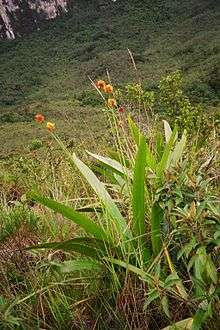Rapateaceae
The Rapateaceae are a family of flowering plants. The botanical name has been recognized by most taxonomists.
| Rapateaceae | |
|---|---|
 | |
| Stegolepis guianensis | |
| Scientific classification | |
| Kingdom: | Plantae |
| Clade: | Tracheophytes |
| Clade: | Angiosperms |
| Clade: | Monocots |
| Clade: | Commelinids |
| Order: | Poales |
| Family: | Rapateaceae Dumort.[1] |
The APG II system of 2003 also recognizes this family, and assigns it to the order Poales in the clade commelinids, in the monocots. This represents a slight change from the APG system, 1998, which left the family unplaced as to order, but placed it in the same clade (although it used the spelling "commelinoids"). The family is divided into 16 genera with a total of about 94 known species,[2] found in tropical South America and tropical west Africa.
The Cronquist system of 1981 also recognized this family and placed it in the order Commelinales in the subclass Commelinidae in class Liliopsida in division Magnoliophyta.
Genera
- Amphiphyllum Gleason
- Cephalostemon R.H.Schomb.
- Duckea Maguire
- Epidryos Maguire
- Guacamaya Maguire
- Kunhardtia Maguire
- Marahuacaea Maguire
- Maschalocephalus Gilg & K.Schum.
- Monotrema Korn.
- Phelpsiella Maguire
- Potarophytum Sandwith
- Rapatea Aubl.
- Saxo-fridericia R.H. Schomb.
- Schoenocephalium Seub.
- Spathanthus Desv.
- Stegolepis Klotzsch ex Korn.
- Windsorina Gleason
gollark: https://dragcave.net/lineage/34NDXThis copper has done 34 ND experiments!
gollark: My first 2G prize!https://dragcave.net/lineage/IPaCj
gollark: Aetheric!
gollark: We really need to start running actual experiments on this sort of thing.
gollark: https://dragcave.net/view/9JjjY
References
- Angiosperm Phylogeny Group (2009). "An update of the Angiosperm Phylogeny Group classification for the orders and families of flowering plants: APG III". Botanical Journal of the Linnean Society. 161 (2): 105–121. doi:10.1111/j.1095-8339.2009.00996.x. Archived from the original on 25 May 2017.
- Christenhusz, M. J. M. & Byng, J. W. (2016). "The number of known plants species in the world and its annual increase". Phytotaxa. Magnolia Press. 261 (3): 201–217. doi:10.11646/phytotaxa.261.3.1.
This article is issued from Wikipedia. The text is licensed under Creative Commons - Attribution - Sharealike. Additional terms may apply for the media files.